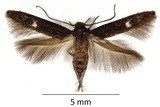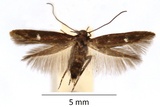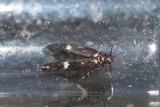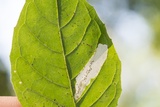Mompha langiella (Hübner, 1796) Species
Last modified: March 8, 2025, 10:26 a.m.
An uncommon species in Belgium, mainly observed in the northern part.
Details
- Classification
- Family: Momphidae > Genus: Mompha > Subgenus: Anybia > Species: Mompha langiella
- Vernacular names
- Zwarte heksenkruidmot (NL), Dunkle Hexenkraut-Fransenmotte (DE)
- Synonyms
- Mompha epilobiella (Römer, 1794), nec (Denis & Schiffermüller, 1775)
- First mention in Belgium
- Fologne E. 1862c. Notes sur quelques lépidoptères observés en Belgique. — Annales de la Société entomologique belge 6: 170–176. On page 174 (as Anybia Langiella. H.). view page
- Status
-
Native
Distribution
Bionomics
The larva mines the leaves of the food plant, at first a gallery in which the frass is deposited in an irregular line in the middle. Later the larva changes to another leaf and causes a blotch. Sometimes several larvae occupy the same leaf, and the blotches merge into one big blotch, occupying the entire leaf surface. When the larvae leave the mine, the leaf turns brownish.
Full-grown larvae pupate in a whitish cocoon attached to a leaf or to leaf litter on the ground, occasionally inside the mine.
The species hibernates in the adult stage. Adults hide in thatch, houses, hollows and other shelters.
Flight periods
One generation a year from July, hibernating till late May of the next year.
Observed on
- Host plant (species):
- Circaea lutetiana, Epilobium hirsutum, Epilobium montanum, Epilobium parviflorum and Epilobium angustifolium
- Host plant (genera):
- Epilobium
Several species of Onagraceae, like Epilobium ssp. or Circaea lutetiana etc.
Habitat
Open areas in woodland, preferably shaded situations.






